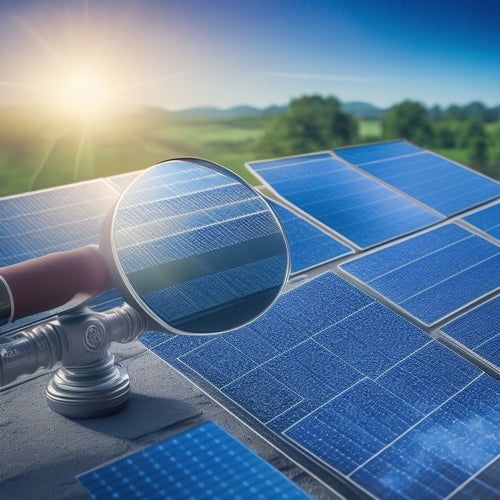
What Are the Essential Components of Solar System Cost in California
Share
When calculating the total cost of a solar system in California, you'll need to take into account essential components like system size and design, panel quality and efficiency, installation labor costs, roof size and condition, permits and inspection fees, inverter and monitoring costs, mounting and tracking systems, and battery backup options. These factors impact the final price, which can vary considerably depending on your specific needs and circumstances. Understanding each component's role in the overall cost will help you make informed decisions and maximize your investment. By digging deeper, you'll reveal the subtleties of each factor and realize how they intersect to create a custom solar solution that's right for you.
Key Takeaways
- System size and design directly impact energy generation and overall cost, with larger systems producing more energy at a higher cost.
- High-quality solar panels with high efficiency ratings yield better returns on investment, despite higher upfront costs.
- Installation labor costs vary depending on complexity, regional market rates, and the experience of the installation team.
- Roof size and condition affect the number of solar panels and overall system cost, with larger roofs accommodating more panels.
- Inverter and monitoring costs, including the type of inverter and monitoring package, can range from $2,000 to $5,000, depending on the system's size and complexity.
System Size and Design
When sizing up a solar system for your California property, the system size and design play an essential role in determining the overall cost.
You'll need to evaluate how many panels you'll need to generate the energy you require. A larger system will naturally cost more, but it'll also produce more energy.
The design of your system is fundamental too - the orientation of your panels can greatly impact energy production. For example, a south-facing system will generate more energy than one facing east or west.
The system's design also affects the number of panels you'll need. A well-designed system will maximize energy production while minimizing the number of panels required. This, in turn, can reduce the overall cost.
You'll want to work with a solar installer who can assess your energy needs and design a system that meets those needs efficiently.
By getting the system size and design right, you can optimize energy production while keeping costs under control.
With the right system, you'll be generating clean energy and saving money on your utility bills in no time.
Panel Quality and Efficiency
Since you're investing in a solar system for your California property, you want to guarantee you're getting the best possible return on that investment. One vital aspect to take into account is the quality and efficiency of the solar panels. High-quality panels with high efficiency ratings will generate more electricity per hour of sunshine, resulting in greater savings on your energy bills.
When evaluating panel quality, look for manufacturers that offer a lengthy panel lifespan, typically 25 years or more. This confirms your system will continue to perform effectively for decades to come.
Efficiency ratings, usually expressed as a percentage, indicate how well the panels convert sunlight into electricity. Higher efficiency ratings translate to more power per panel, reducing the number of panels needed to meet your energy needs.
While high-efficiency panels may come at a higher upfront cost, they can provide significant long-term benefits. Be sure to research and compare different panel options to find the best balance of quality, efficiency, and cost for your California solar system.
Installation Labor Costs
With your solar panel selection in place, the next essential factor to take into account is the cost of installation labor. This cost is determined by the complexity of the installation, the installation techniques used, and the labor market in your area.
In California, labor costs can vary greatly depending on the region, city, and even neighborhood.
You'll want to evaluate the experience and qualifications of the installation team, as well as the company's reputation and warranty offered. A more experienced team may charge higher labor rates, but they'll likely complete the job more efficiently and with higher quality workmanship.
Additionally, some installers may offer different pricing tiers based on the type of installation, such as ground-mounted or roof-mounted systems.
Be certain to get quotes from multiple installers to compare labor costs and find the best value for your money.
Roof Size and Condition
Your solar panel installation's success depends on a solid understanding of your roof's size and condition.
The size of your roof affects the number of solar panels you can install, which in turn impacts the overall cost of your solar system. A larger roof can accommodate more panels, increasing energy production and reducing your electricity bill. However, it also means higher upfront costs.
The condition of your roof is equally important. A roof in poor condition may require repairs or replacement before installing solar panels, adding to the overall cost.
You should also consider roof orientation, as a south-facing roof receives more sunlight and is ideal for solar panels. A shading analysis should also be conducted to determine if any obstructions, such as trees or neighboring buildings, will affect energy production.
Permits and Inspection Fees
The blueprint for your solar panel installation isn't complete without permits and inspections. You'll need to obtain the necessary permits from your local government before installation can begin. This includes a building permit, electrical permit, and potentially others depending on your location and system design.
The permit application process typically involves submitting your system design plans and paying a fee, which varies by jurisdiction. Once your application is approved, you'll receive a permit that allows your installer to proceed with the installation.
Here's a breakdown of what you can expect during the inspection timeline:
| Inspection Type | Purpose |
|---|---|
| Initial Inspection | Verify system design and installation compliance with local building codes |
| Mid-Installation Inspection | Confirm electrical connections and wiring meet safety standards |
| Final Inspection | Confirm the system is installed correctly and ready for operation |
Keep in mind that inspection fees are typically included in your overall installation cost. Be certain to discuss the permit application and inspection timeline with your installer to understand what's included and what you can expect during the process.
Inverter and Monitoring Costs
Solar panel systems rely on inverters to convert DC power into usable AC power for your home. As a vital component, inverters account for a significant portion of your overall solar system cost in California.
You'll need to take into account the type and quality of inverter technology, as well as the associated costs. String inverters, microinverters, and power optimizers are popular options, each with their pros and cons. Microinverters, for instance, offer greater flexibility and monitoring capabilities, but come at a higher cost.
Monitoring software is another important aspect of your solar system. This software enables you to track your energy production, identify potential issues, and optimize your system's performance.
You can opt for a basic monitoring package or upgrade to more advanced features, such as real-time monitoring and energy storage integration. When calculating your inverter and monitoring costs, be sure to factor in the cost of the hardware, installation, and any ongoing software subscriptions.
On average, you can expect to pay between $2,000 and $5,000 for a high-quality inverter and monitoring system, depending on the size and complexity of your solar panel installation.
Mounting and Tracking Systems
Mounting and Tracking Systems
How do you confirm your solar panels are securely fastened to your roof or ground, and ideally angled to capture maximum sunlight? The answer lies in the mounting and tracking systems, which are essential components of your solar system. These systems guarantee your panels are safely installed and oriented to optimize energy production.
Mounting materials can vary depending on your roof type and size. Here's a breakdown of common mounting options:
| Roof Type | Mounting Material | Cost Range |
|---|---|---|
| Asphalt Shingle | Rail-based mounting | $1.50 - $2.50 per watt |
| Clay/Concrete Tile | Tile hook mounting | $2.00 - $3.50 per watt |
| Metal Roof | Clamp-based mounting | $2.50 - $4.00 per watt |
| Ground-Mount | Post-based mounting | $3.00 - $5.00 per watt |
| Flat Roof | Ballasted mounting | $1.00 - $2.00 per watt |
Tracking technology, on the other hand, allows your panels to adjust their angle to capture more sunlight throughout the day. While it can increase energy production, it also adds to the overall cost. You'll need to weigh the benefits against the additional expense to determine if tracking technology is right for your solar system.
Battery Backup Options
Energy security is what you gain with battery backup options, which let you store excess energy generated by your solar panels during the day for use during power outages or at night. This means you'll have a reliable source of energy when you need it most.
Lithium-ion batteries are a popular choice for solar backup systems due to their high energy density, long lifespan, and low maintenance requirements.
When considering battery backup options, you'll want to think about your energy needs and the size of your solar panel system. A larger battery bank can provide more backup power, but it will also increase the overall cost of your system.
Fortunately, California offers solar incentives that can help offset the cost of a battery backup system. The Self-Generation Incentive Program (SGIP) provides rebates for energy storage systems, making it more affordable to add a battery backup to your solar panel system.
Frequently Asked Questions
Can I Install Solar Panels on a Rented Property in California?
You can install solar panels on a rented property in California if you negotiate with your landlord and include provisions in your lease agreement that respect your renter rights, ensuring a mutually beneficial arrangement.
Are There Any Tax Credits for Solar Systems in California?
As you traverse the sun-kissed scenery of California, you're likely to stumble upon a wealth of incentives; you'll uncover federal incentives, like the Solar Investment Tax Credit, and state-specific solar rebates, which can greatly reduce the cost of your solar system.
How Long Does a Typical Solar Panel Installation Take?
You'll find that a typical solar panel installation takes around 3-5 days, depending on the project's complexity and factors like roof size, but the entire installation timeline can span 2-3 months, considering permits and inspections.
Can I DIY Solar Panel Installation to Save Money?
Congratulations, you're about to become a solar cowboy, lassoing those panels onto your roof solo! But, hold your horses, partner - DIY considerations mean managing installation permits, electrical connections, and local building codes, which might just leave you feeling more tangled than a mess of cowboy ropes.
Are Solar Panels Durable Enough to Withstand California Wildfires?
You'll be relieved to know that solar panels are designed to withstand California wildfires, thanks to fire-resistant materials and compliance with wildfire regulations, ensuring your system remains safe and functional even in high-risk areas.
Conclusion
As you consider going solar in California, remember that it's like building a puzzle - each component fits together to create a complete image. The system size and design are the foundation, panel quality and efficiency are the vital middle pieces, and installation labor costs, permits, and inspection fees are the necessary glue. Don't forget the inverter and monitoring costs, mounting and tracking systems, and battery backup options - they're the final touches that bring it all together. In the end, a well-crafted solar system is like a work of art, generating clean energy and savings for years to come.
Related Posts
-

Solar Panel System Certification Costs: A 10-Point Breakdown
You're looking to understand the costs associated with solar panel system certification. Your total certification cos...
-

What You Need to Know About Permits and Inspections
You need to navigate the complex landscape of permits and inspections to guarantee your project complies with local z...
-

Top 10 DIY Conversion Kit Reviews and Tips
You're taking the first step towards electrifying your ride, and with the right DIY conversion kit, you'll be cruisin...


